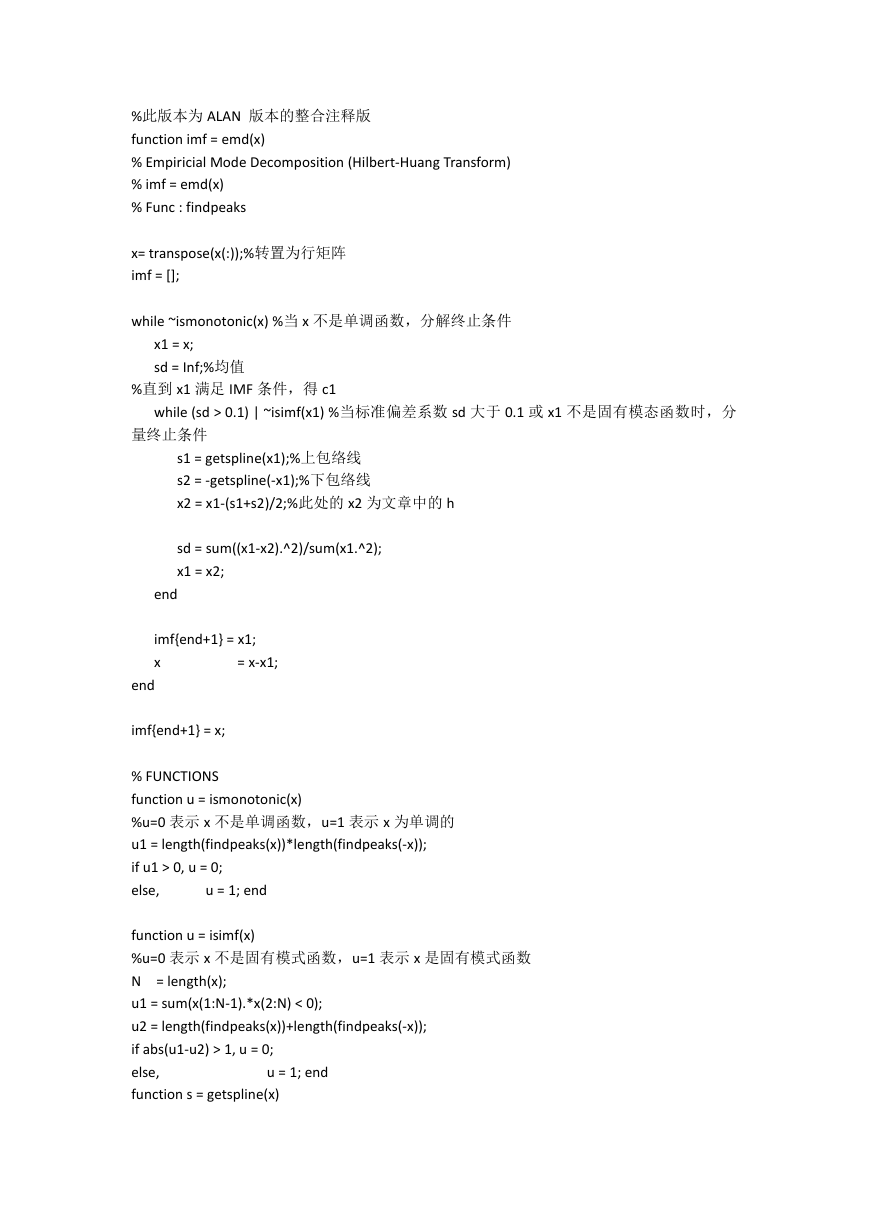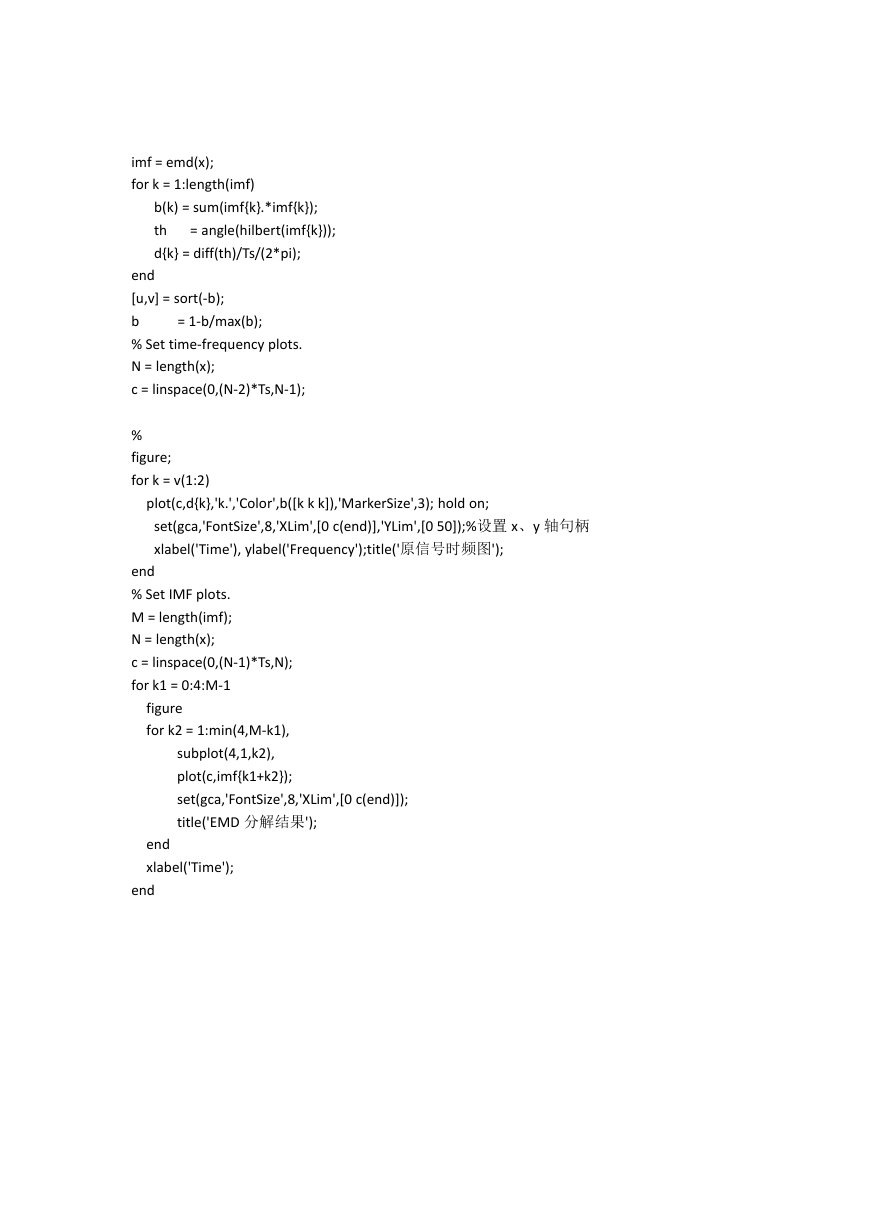%此版本为 ALAN 版本的整合注释版
function imf = emd(x)
% Empiricial Mode Decomposition (Hilbert-Huang Transform)
% imf = emd(x)
% Func : findpeaks
x= transpose(x(:));%转置为行矩阵
imf = [];
while ~ismonotonic(x) %当 x 不是单调函数,分解终止条件
x1 = x;
sd = Inf;%均值
%直到 x1 满足 IMF 条件,得 c1
while (sd > 0.1) | ~isimf(x1) %当标准偏差系数 sd 大于 0.1 或 x1 不是固有模态函数时,分
量终止条件
s1 = getspline(x1);%上包络线
s2 = -getspline(-x1);%下包络线
x2 = x1-(s1+s2)/2;%此处的 x2 为文章中的 h
sd = sum((x1-x2).^2)/sum(x1.^2);
x1 = x2;
end
imf{end+1} = x1;
x
end
= x-x1;
imf{end+1} = x;
% FUNCTIONS
function u = ismonotonic(x)
%u=0 表示 x 不是单调函数,u=1 表示 x 为单调的
u1 = length(findpeaks(x))*length(findpeaks(-x));
if u1 > 0, u = 0;
else,
u = 1; end
function u = isimf(x)
%u=0 表示 x 不是固有模式函数,u=1 表示 x 是固有模式函数
N = length(x);
u1 = sum(x(1:N-1).*x(2:N) < 0);
u2 = length(findpeaks(x))+length(findpeaks(-x));
if abs(u1-u2) > 1, u = 0;
else,
function s = getspline(x)
u = 1; end
�
%三次样条函数拟合成元数据包络线
N = length(x);
p = findpeaks(x);
s = spline([0 p N+1],[0 x(p) 0],1:N);
-------------------------------------------------------------------------------
--------------------------------------------------------------------------------
function n = findpeaks(x)
% Find peaks.找到极值 ,n 为极值点所在位置
% n = findpeaks(x)
n
u
n(u) = n(u)+1;
= find(diff(diff(x) > 0) < 0);
= find(x(n+1) > x(n));
------------------------------------------------------------------------------------------
----------------------------------------------------------------------------------------
function plot_hht00(x,Ts)
% 双边带调幅信号的 EMD 分解
% Plot the HHT.
% plot_hht(x,Ts)
%
% :: Syntax
%
%
%
% Func : emd
% Get HHT.
clear all;
close all;
Ts=0.0005;
t=0:Ts:10;
% 采样率 2000HZ
The array(列) x is the input signal and Ts is the sampling period(取样周期).
Example on use: [x,Fs] = wavread('Hum.wav');
plot_hht(x(1:6000),1/Fs);
% 调幅信号
%x=sin(2*pi*t).*sin(40*pi*t);
x=sin(2*pi*t);
s1 = getspline(x);%上包络线
s2 = -getspline(-x);%上包络线
x1 = (s1+s2)/2;%此处的 x2 为文章中的 h
figure;
plot(t,x);xlabel('Time'), ylabel('Amplitude');title('双边带调幅信号');hold on;
plot(t,s1,'-r');
plot(t,s2,'-r');
plot(t,x1,'g');
�
imf = emd(x);
for k = 1:length(imf)
b(k) = sum(imf{k}.*imf{k});
th
d{k} = diff(th)/Ts/(2*pi);
= angle(hilbert(imf{k}));
= 1-b/max(b);
end
[u,v] = sort(-b);
b
% Set time-frequency plots.
N = length(x);
c = linspace(0,(N-2)*Ts,N-1);
%
figure;
for k = v(1:2)
plot(c,d{k},'k.','Color',b([k k k]),'MarkerSize',3); hold on;
set(gca,'FontSize',8,'XLim',[0 c(end)],'YLim',[0 50]);%设置 x、y 轴句柄
xlabel('Time'), ylabel('Frequency');title('原信号时频图');
end
% Set IMF plots.
M = length(imf);
N = length(x);
c = linspace(0,(N-1)*Ts,N);
for k1 = 0:4:M-1
figure
for k2 = 1:min(4,M-k1),
subplot(4,1,k2),
plot(c,imf{k1+k2});
set(gca,'FontSize',8,'XLim',[0 c(end)]);
title('EMD 分解结果');
end
xlabel('Time');
end
�






 2023年江西萍乡中考道德与法治真题及答案.doc
2023年江西萍乡中考道德与法治真题及答案.doc 2012年重庆南川中考生物真题及答案.doc
2012年重庆南川中考生物真题及答案.doc 2013年江西师范大学地理学综合及文艺理论基础考研真题.doc
2013年江西师范大学地理学综合及文艺理论基础考研真题.doc 2020年四川甘孜小升初语文真题及答案I卷.doc
2020年四川甘孜小升初语文真题及答案I卷.doc 2020年注册岩土工程师专业基础考试真题及答案.doc
2020年注册岩土工程师专业基础考试真题及答案.doc 2023-2024学年福建省厦门市九年级上学期数学月考试题及答案.doc
2023-2024学年福建省厦门市九年级上学期数学月考试题及答案.doc 2021-2022学年辽宁省沈阳市大东区九年级上学期语文期末试题及答案.doc
2021-2022学年辽宁省沈阳市大东区九年级上学期语文期末试题及答案.doc 2022-2023学年北京东城区初三第一学期物理期末试卷及答案.doc
2022-2023学年北京东城区初三第一学期物理期末试卷及答案.doc 2018上半年江西教师资格初中地理学科知识与教学能力真题及答案.doc
2018上半年江西教师资格初中地理学科知识与教学能力真题及答案.doc 2012年河北国家公务员申论考试真题及答案-省级.doc
2012年河北国家公务员申论考试真题及答案-省级.doc 2020-2021学年江苏省扬州市江都区邵樊片九年级上学期数学第一次质量检测试题及答案.doc
2020-2021学年江苏省扬州市江都区邵樊片九年级上学期数学第一次质量检测试题及答案.doc 2022下半年黑龙江教师资格证中学综合素质真题及答案.doc
2022下半年黑龙江教师资格证中学综合素质真题及答案.doc